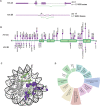Expanded phenotypic spectrum of neurodevelopmental and neurodegenerative disorder Bryant-Li-Bhoj syndrome with 38 additional individuals
- PMID: 38678163
- PMCID: PMC11291762
- DOI: 10.1038/s41431-024-01610-1
Expanded phenotypic spectrum of neurodevelopmental and neurodegenerative disorder Bryant-Li-Bhoj syndrome with 38 additional individuals
Erratum in
-
Correction: Expanded phenotypic spectrum of neurodevelopmental and neurodegenerative disorder Bryant-Li-Bhoj syndrome with 38 additional individuals.Eur J Hum Genet. 2024 Aug;32(8):1032. doi: 10.1038/s41431-024-01659-y. Eur J Hum Genet. 2024. PMID: 39060653 Free PMC article. No abstract available.
Abstract
Bryant-Li-Bhoj syndrome (BLBS), which became OMIM-classified in 2022 (OMIM: 619720, 619721), is caused by germline variants in the two genes that encode histone H3.3 (H3-3A/H3F3A and H3-3B/H3F3B) [1-4]. This syndrome is characterized by developmental delay/intellectual disability, craniofacial anomalies, hyper/hypotonia, and abnormal neuroimaging [1, 5]. BLBS was initially categorized as a progressive neurodegenerative syndrome caused by de novo heterozygous variants in either H3-3A or H3-3B [1-4]. Here, we analyze the data of the 58 previously published individuals along 38 unpublished, unrelated individuals. In this larger cohort of 96 people, we identify causative missense, synonymous, and stop-loss variants. We also expand upon the phenotypic characterization by elaborating on the neurodevelopmental component of BLBS. Notably, phenotypic heterogeneity was present even amongst individuals harboring the same variant. To explore the complex phenotypic variation in this expanded cohort, the relationships between syndromic phenotypes with three variables of interest were interrogated: sex, gene containing the causative variant, and variant location in the H3.3 protein. While specific genotype-phenotype correlations have not been conclusively delineated, the results presented here suggest that the location of the variants within the H3.3 protein and the affected gene (H3-3A or H3-3B) contribute more to the severity of distinct phenotypes than sex. Since these variables do not account for all BLBS phenotypic variability, these findings suggest that additional factors may play a role in modifying the phenotypes of affected individuals. Histones are poised at the interface of genetics and epigenetics, highlighting the potential role for gene-environment interactions and the importance of future research.
© 2024. The Author(s).
Conflict of interest statement
The authors declare no competing interests.
Figures



References
-
- Maver A, Čuturilo G, Ruml SJ, Peterlin B. Clinical Next Generation Sequencing Reveals an H3F3A Gene as a New Potential Gene Candidate for Microcephaly Associated with Severe Developmental Delay, Intellectual Disability and Growth Retardation. Balk J Med Genet. 2019;22:65–8. 10.2478/bjmg-2019-0028 - DOI - PMC - PubMed
MeSH terms
Substances
Grants and funding
- T32GM008638/U.S. Department of Health & Human Services | NIH | National Institute of General Medical Sciences (NIGMS)
- 1F30HD112125/U.S. Department of Health & Human Services | NIH | Eunice Kennedy Shriver National Institute of Child Health and Human Development (NICHD)
- 5T32HG009495/U.S. Department of Health & Human Services | NIH | National Human Genome Research Institute (NHGRI)
- P50 HD109879/HD/NICHD NIH HHS/United States
- T32 HG009495/HG/NHGRI NIH HHS/United States
LinkOut - more resources
Full Text Sources

